Robotic Process Automation: Setting the course for the successful automation of corporate processes
April 27, 2020

April 27, 2020

RPA refers to the integration of software robots (bots) into the existing IT environment and enables the automation of repeating, rule-based processes. Software bots simulate human interactions with user interfaces of software systems and work regardless of function and application. RPA is also regarded as the second of four stages of automating IT processes. For an effective flow, the underlying data must be completely structured so that rule-based automation can succeed.
Figure 1 depicts a fully automated process with RPA. End-to-end processes can be automated completely and require the intervention of employees only if escalations are required. The software bots can be designed, for example, so that incoming e-mails “trigger” the automated process and it then runs completely automatically regardless of the application.
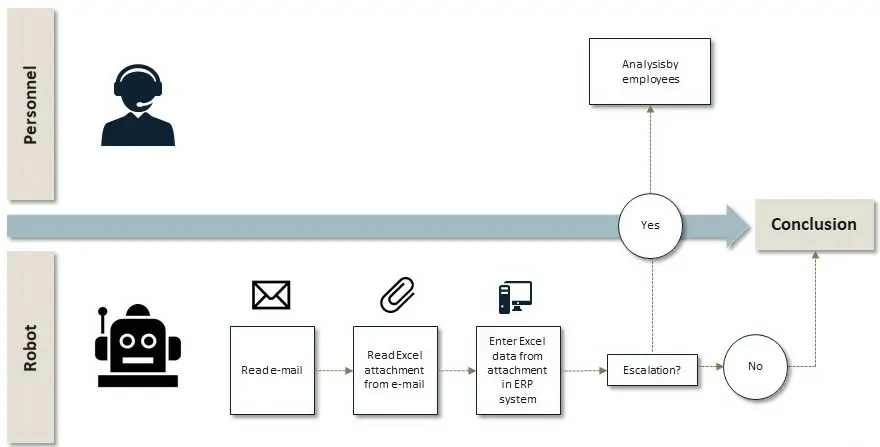
Fully structured data and rule-based processes are required for the successful application of RPA software. From this arise typical use cases. Especially suitable are processes that have the following characteristics, for example:
In order to identify processes that are suitable for automation, it makes sense to analyze them using so-called qualifiers.
On the one hand, the focus is on the “nature of work.” On which rules is the process based? Can the process be described with a series of dependent steps (yes/no)? Is it possible to map all results in advance? For successful automation, it is important that the processes flow based on rules.
Furthermore, you must examine the “stability” of a process. Are the process steps stable over the course of time? Can you count on changes in the process flow? How much has the process changed in recent years? How has the system environment changed? High stability guarantees a higher success quota for automation. Last, you analyze the “data type.” What are the formats of the input and output data? Does the data exist in text, numeric or image format? Is it necessary to interpret images during the process? The degree of digitalization of the data determines how well-suited a process is for automation. A numeric database simplifies the automation of a process, while in contrast, for text or image format, you need additional features such as OCR (Optical Character Recognition). Figure 2 depicts a brief summary of the properties and application possibilities of RPA.
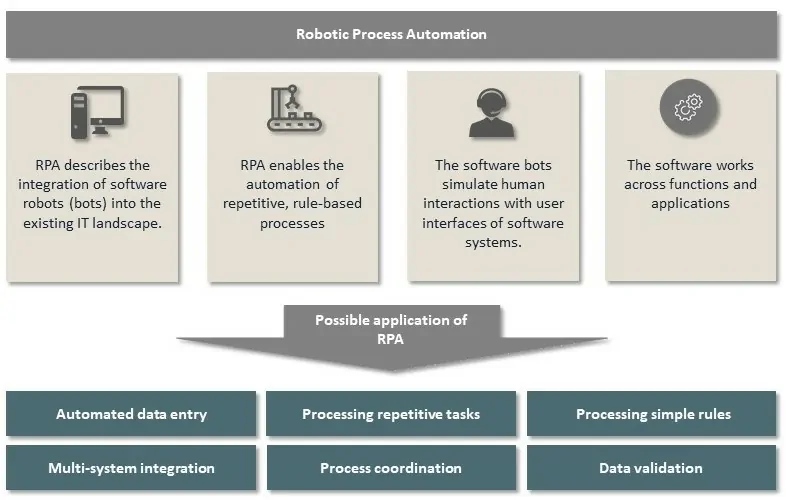
Many companies are currently in a transformation phase in which the existing process and IT environments are being examined and redesigned. In the SAP environment, for example, there are ever more thoughts of introducing S/4HANA from scratch; that is, projects where existing structures and processes are examined intensively for existing inefficiencies and optimization potential. This is already an essential component of the potential analysis for automation.
Here, the guiding idea must be: “Automation follows standardization.” It is therefore worthwhile for these companies to incorporate the topic of RPA into current projects and consideration about the restructuring of the existing process and IT environment.
Figure 3 depicts how the time after completing the standardization of finance processes is a good time to automate individual processes with RPA. With the roll-out of the new S/4HANA template, similar processes can be automated.
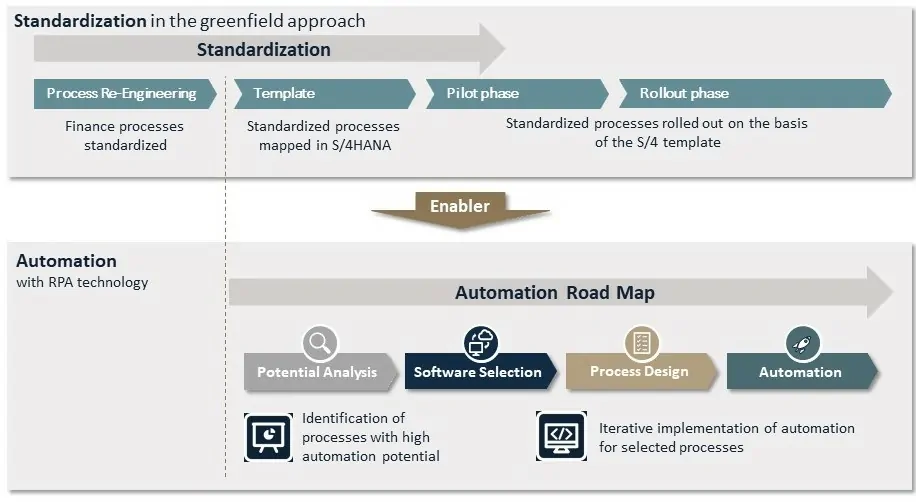
The automation of IT processes can bring many advantages for a company’s efficiency and effectiveness. In a nutshell, these benefits can be divided into the following four categories:
Thanks to automation, the throughput times for processes are much shorter. The larger the volume of automated processes, the greater the time saving. Thus, in the future, routine tasks can be taken over and employees can take care of other, hopefully more complex, tasks.
The seamless integration into the existing IT environment guarantees security and consistency int he processes. Once processes have been designed, their quality always remains the same.
The cost savings can vary. Here, you can assume – depending on the RPA model – an average ROI of < 1 year.
The reduction of the human factor is another advantage that should not be overlooked. Software bots work 24/7 and don’t care about working hours, vacations, and other times when employees might typically be absent. In addition to longer working hours, automated processes are also much less likely to make mistakes (with well-automated processes, there are nearly no errors). Because employees are human, slips happen, and the additional working hours required to correct these slips are no longer necessary.
There are process areas with automation potential in all essential financial functions, e.g. in order-to-cash, intercompany reconciliation, and financial reporting. Automation can be scaled individually and creates various degrees of optimization potential in a financial organization’s processes in order to get faster, better, cheaper or less dependent on personnel. We use the valantic “heat map” in Figure 4 to identify your individual automation potential in finance processes.
For example, you can examine payment receipt processing in the order-to-cash process. With RPA, completely automatic assignment and booking of payments received is possible. The processing of incoming payments requires a lot of work and can result in personnel bottlenecks and error costs. With the end-to-end solution introduced, rule-based business processes span applications – from collection of the tasks to task distribution and processing – automatically. The “bots” work in the same SAP inbox as the customer’s employees and process all individual incoming payments. After matching important parameters such as designated use and customer data, the incoming payments are booked automatically in SAP. This can result in a reduction of mistaken bookings and the resulting error costs. Simultaneously, all security requirements are adhered to. In addition, this can free employees from monotonous and repetitive tasks. The training effort required is minimal since only the operation of an application is required.
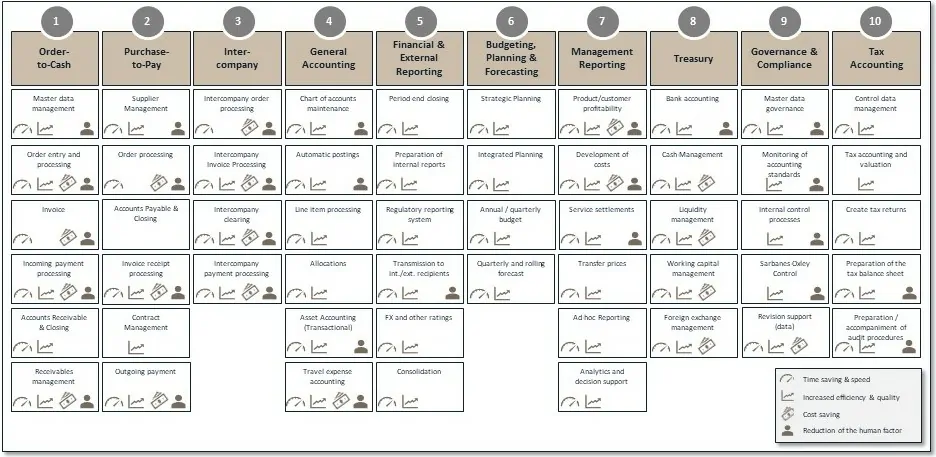
There are three overlapping areas in which the costs of an implementation of RPA software arise: process identification and mapping, the cost of buying the software, and personnel costs.
For process identification and mapping, the costs for the evaluation and selection of one or several business processes for automation must be considered. The costs of buying the software include the implementation costs, licensing, and training. The personnel costs include all costs related to the restructuring and hiring due to the automation project. It’s not a trivial matter to forecast an ROI for an automation project, since it depends on many variables, including the size and sector of a company, for example. On average, however, it can be said that the ROI is less than one year.
Of course it is important to reap the efficiency potential identified quickly and to realize quick wins. To achieve demonstrable successes as quickly as possible, the valantic implementation approach includes the following four phases:
Each of these four phases is clearly distinguished and results in clearly defined results, which we make available in professionally prepared form.
Each phase can also be commissioned individually, so that complete cost transparency is guaranteed and the customer can decide at any time whether he would like to continue down the path of automation with us.
Figure 5 provides a detailed overview of the valantic implementation approach.
Phase 1 is a unique selling proposition of the valantic approach. Through a detailed evaluation of qualifiers and benefits per business process (up to level 5), we use our own process heat map to create a very clear prioritization of the processes to be automated. Here, all of the customer’s needs are addressed individually and a generic approach is explicitly ruled out..
For the creation of a rated short list of the relevant RPA products based process selection, we can rely on an extensive database in which we have analyzed and evaluated all of the tools on the market.
The additional extensive quotation includes, in addition to the conception and implementation phase, complete test management, user trainings, and post go-live support.
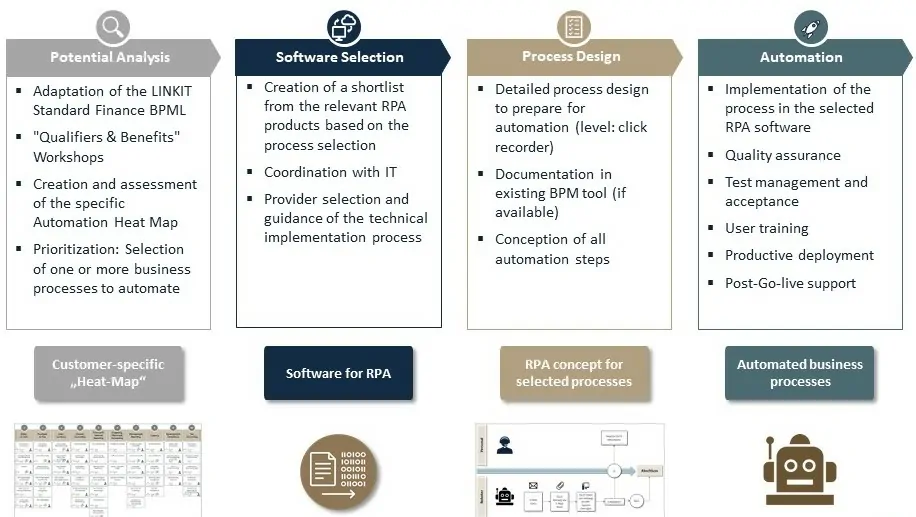
Robotic Process Automation offers companies a great opportunity to automate repetitive, time-consuming processes without having to intervene extensively into the existing IT environment. The use cases are many and varied and the benefits evident. In addition to time and cost savings, employees can also be freed of monotonous work processes and devote themselves to other activities at the company. RPA has many use cases in finance and valantic can help you to identify and automate these. In the process, we consistently use a four-stage implementation approach, which ranges from potential analysis to post go-live support. Our expertise at the interface between finance, IT, and automation guarantees you successful entry into the age of automation.
Don't miss a thing.
Subscribe to our latest blog articles.